
Content
2013-14 State of the Future
The Future Now Show
February Event in London: the future of Collective Intelligence
The Asian Square Dance – Part 4
Club of Amsterdam blog
News about the Future
Recommended Book: Social Collective Intelligence: Combining the Powers of Humans and Machines to Build a Smarter Society
Welcome to the Club of Amsterdam Journal.
In this show we are talking about Governance for All / Philosophy unbound / Robotics and A.I. and … featuring Karin Jironet, Markus Petz, Katie Aquino, aka “Miss Metaverse”, Annegien Blokpoel and Paul Holister The Future Now Show
…. and join our event in London about the future of Collective Intelligence, Wednesday, February 11, 7-9pm.
With Hardy Schloer about:
How will humanity manage the transition from a human based intelligence to a superior machine intelligence in a constructive, peaceful and practical way?
Felix F Bopp, Founder & Chairman
2013-14 State of the Future
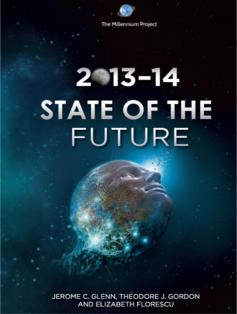
By Jerome C. Glenn, Theodore J. Gordon, and Elizabeth Florescu. The Millennium Project
Executive Summary
The global situation for humanity continues to improve in general, but at the expense of the environment. People around the world are becoming healthier, wealthier, better educated, more peaceful, and increasingly connected, and they are living longer. The child mortality rate has dropped 47% since 1990, extreme poverty in the developing world fell from 50% in 1981 to 21% in 2010, primary school completion rates grew from 81% in 1990 to 91% in 2011, only one transborder war occurred in 2013, nearly 40% of humanity is connected via the Internet, and life expectancy has increased ten years over the past twenty years to reach 70.5 years today.
However, water tables are falling on all continents, intrastate conflicts and refugee numbers are increasing, glaciers are melting, income gaps are increasingly obscene, coral reefs are dying, ocean acidity is increasing, ocean dead zones have doubled every decade since the 1960s, half the world’s topsoil has been destroyed, youth unemployment has reached dangerous proportions, traffic jams and air pollution are strangling cities, $1–1.6 trillion is paid in bribes, organized crime takes in twice the money per year as all military budgets combined, civil liberties are increasingly threatened, and half of the world is potentially unstable.
Massive transitions from isolated subsistence agriculture and industrial economies to an emerging global Internet–connected pluralistic civilization are occurring at unprecedented speed and uncertainties. Monitoring major indicators of progress from health and education to water and energy shows we are winning more than we are losing — but where we are losing is very serious. After seventeen years of continuous monitoring of global change as documented in the annual State of the Future reports, it is clear that humanity has the ideas and resources to address its global challenges, but it has not yet shown the leadership, policies, and management on the scale necessary to guarantee a better future. It is also clear from The Millennium Project’s global futures research over all these years that there is greater agreement about how to build a better future than is evident in the one-way media that holds audiences by the drama of disagreement, which is reinforcing polarization. When you consider the many wrong decisions and good decisions not taken — day after day and year after year around the world — it is amazing that we are still making as much progress as we are.
The IMF expects the global economy to grow from 3% in 2013 to 3.7% during 2014 and possibly 3.9% in 2015. With world population of 7.2 billion growing at 1.1% in 2013, the global per capita income is increasing at 2.6% per year. The world is reducing poverty faster than many thought was possible, but the divide between the rich and poor is growing faster than many want to admit. According to Oxfam, the total wealth of the richest 85 people equals that of 3.6 billion people in the bottom half of the world’s economy, and half of the world’s wealth is owned by just 1% of the population. We need to continue the successful efforts that are reducing poverty, but we also need to focus far more seriously on reducing income inequality if long-term instability is to be avoided.
Because the world is better educated and increasingly connected, people are becoming less tolerant of the abuse of elite power than in the past. Because youth unemployment is growing, more people have more time to do something about this abuse. Unless these elites open the conversation about the future with the rest of their populations, unrest and revolutions are likely to continue and increase. The executive summary of the 2008 State of the Future stated:
Half the world is vulnerable to social instability and violence due to rising food and energy prices, failing states, falling water tables, climate change, decreasing water-food-energy supply per person, desertification, and increasing migrations due to political, environmental, and economic conditions.
Unfortunately, these factors contributing to social instability have continued to worsen over the past five years, leading to the social unrest we see today in many parts of the world. The number of wars and battlerelated deaths has been decreasing, however. Yet worrisome territorial tensions among Asian countries continue to slowly escalate, cyber attacks and espionage are rapidly increasing, and overlapping jurisdictions for energy access to the melting Arctic will be tests of humanity’s maturity to see if these can be peacefully resolved. The US and Russia argue about how to stop the bloodshed in Syria while a third of Syria’s 21 million people are displaced in their country or refugees in neighboring countries. The number of nuclear weapons is falling and nation-state transborder wars are rare, yet conflicts within countries are increasing, and the world ignores 6 million war-related deaths in the Congo.
At the same time, the world is increasingly engaged in many diverse conversations about the right way to relate to the environment and our fellow humans and about what technologies, economics, and laws are right for our common future. These great conversations are emerging from countless international negotiations, the evolution of standards established by the ISO, the preparations for the post-2015 UN Development Goals and other UN gatherings, and thousands of Internet discussion groups and big data analyses. Humanity is slowly but surely becoming aware of itself as an integrated system of cultures, economies, technologies, natural and built environments, and governance systems.
These great conversations will be better informed if we realize that the world is improving better than most pessimists know and that future dangers are worse than most optimists indicate. Better ideas, new tech, and creative management approaches are popping up all over the world, but the lack of imagination and courage to make serious change is drowning the innovations needed to make the world work for all.
Meanwhile, the world is beginning to automate jobs more broadly and quickly than during the industrial revolution and initial stages of the information age. How many truck and taxicab drivers will future self-driving cars replace? How many will lose their jobs to robotic manufacturing? Or telephone support people to AI telephone systems? The number of employees per business revenue is falling, giving rise to employment-less economic growth. New possibilities have to be invented, such as one-person Internet-based self-employment, for finding markets worldwide rather than looking for local jobs. Successfully leapfrogging slower linear development processes in lower-income countries is likely to require implementing futuristic possibilities — from 3D printing to seawater agriculture — and making increasing individual and collective intelligence a national objective of each country.
The explosive, accelerating growth of knowledge in a rapidly changing and increasingly interdependent world gives us so much to know about so many things that it seems impossible to keep up. At the same time, we are flooded with so much trivial news that serious attention to serious issues gets little interest, and too much time is wasted going through useless information.
The Millennium Project has gathered the insights from creative and knowledgeable people around the world to identify and update prospects for 15 Global Challenges to provide a framework for understanding what is important to know about global change. Chapter 1 presents distilled overviews of each of these challenges so that readers can save time and more easily improve their understanding of our common future compared with more narrowly focused sources scattered around the Internet. Chapter 1 is continually updated online in the Global Futures Intelligence System GFIS can be thought of as a global information utility from which different readers can draw different value for improving understanding and decisions. In addition to succinct but relatively detailed descriptions of the current situation and forecasts, recommendations to address each challenge are also included. Some examples suggested in Chapter 1 include:
- Establish a U.S.-China 10-year environmental security goal to reduce climate change and improve trust.
- Grow meat without growing animals, to reduce water demand and GHG emissions.
- Develop seawater agriculture for biofuels, carbon sink, and food without rain.
- Build global collective intelligence systems for input to long-range strategic plans.
- Create tele-nations connecting brains overseas to the development process back home.
- Establish trans-institutions for more effective implementation of strategies.
- Detail and implement a global counter-organized crime strategy.
- Use the State of the Future Index as an alternative to GDP as a measure of progress for the world and nations.
The world is in a race between implementing ever-increasing ways to improve the human condition and the seemingly ever-increasing complexity and scale of global problems. So, how is the world doing in this race? What’s the score so far?
A review of the trends of the 30 variables used in The Millennium Project’s global State of the Future Index (see Box 1) provides a score card on humanity’s performance in addressing the most important challenges.
The State of the Future Index is a measure of the 10-year outlook for the future based on historical data for the last 20 years. It is constructed with key variables and forecasts that, in the aggregate, depict whether the future promises to be better or worse. The SOFI is intended to show the directions and intensity of change and to identify the factors responsible. It provides a mechanism for studying the relationships among the items in a system. It has been produced by The Millennium Project since 2000.
The variables included in SOFI were selected from a set of indicators rated by an international Delphi panel for their capacity for showing progress or regress on the 15 Global Challenges and the availability of at least 20 years of reliable historical data. The variables were submitted several times to an international panel selected by The Millennium Project’s Nodes to forecast the best and worst values for each variable in 10 years. These were used for the normalization and integration of all the variables into a single index (See “State of the Future Index” in GFIS’s Research section for details of the construction of SOFI, annual global SOFIs since 2001, and several national applications.) and for computation of the State of the Future Index. The index shown in Figure 1 indicates a slower progress since 2007, although the overall outlook is promising.
The World Report Card
Each of the 30 variables can be examined to show where we are winning, where we are losing, and where there is unclear or little progress, producing a report card for the world. Figures 2, 3, and 4 show the indicators with their historical data and projections grouped by progress criterion.
Box 1.
Variables used in the 2013–14 State of the Future Index
1. GNI per capita, PPP (constant 2005 international $)
2. Economic income inequality (share of top 10%)
3. Unemployment, total (% of world labor force)
4. Poverty headcount ratio at $1.25 a day (PPP) (% of population)
5. Levels of corruption (0=highly corrupt; 6=very clean)
6. Foreign direct investment, net inflows (BoP, current $, billions)
7. R&D Expenditures (% of GDP)
8. Population growth (annual %)
9. Life expectancy at birth (years)
10. Mortality rate, infant (per 1,000 live births)
11. Prevalence of undernourishment
12. Health expenditure per capita (current $)
13. Physicians (per 1,000 people)
14. Improved water source (% of population with access)
15. Renewable internal freshwater resources per capita (thousand cubic meters)
16. Ecological Footprint / Biocapacity ratio
17. Forest area (% of land area)
18. CO2emissions from fossil fuel and cement production (billion tones (GtCO2))
19. Energy efficiency (GDP per unit of energy use (constant 2005 PPP $ per kg of oil equivalent))
20. Electricity production from renewable sources, excluding hydroelectric (% of total)
21. Literacy rate, adult total (% of people ages 15 and above)
22. School enrollment, secondary (% gross)
23. Number of wars (conflicts with more than 1,000 fatalities)
24. Terrorism incidents
25. Number of countries and groups that had or still have intentions to build nuclear weapons
26. Freedom rights (number of countries rated free)
27. Voter turnout (% voting population)
28. Proportion of seats held by women in national parliaments (% of members)
29. Internet users (per 100 people)
30. Prevalence of HIV (% of population age 15 and 49)
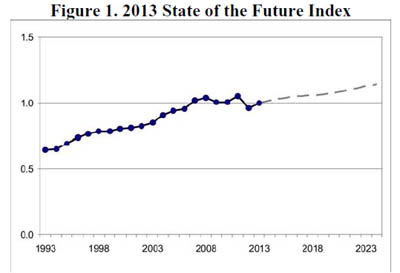
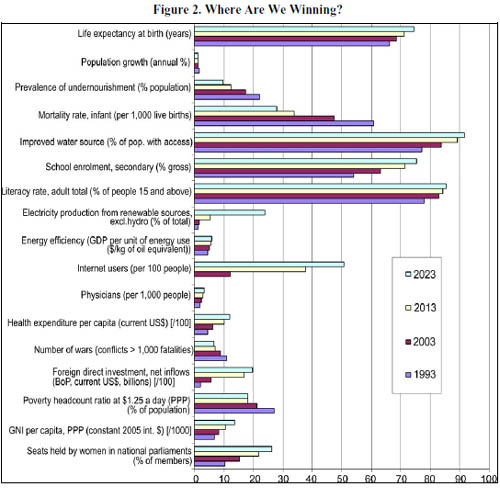
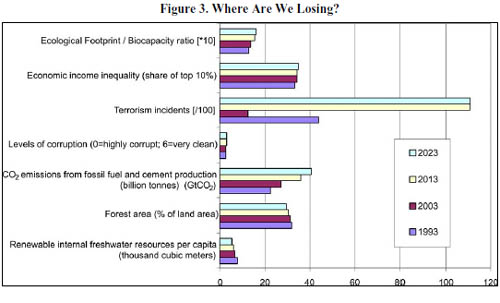
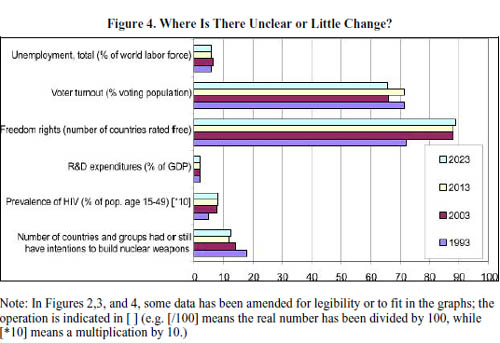
Some Factors to Consider
A great brain race has begun! The EU, U.S., Japan, and China have announced programs to understand how the brain works and apply that knowledge for better computers and to improve our relation to them. Google also is working to create artificial brains to be your personal artificial intelligence assistant. Another great race is on to make supercomputer power available to the masses with advances in IBM’s Watson and with cloud computing by Amazon and others. About 85% of the world’s population is expected to be covered by high–speed mobile Internet in 2017. China already has nearly twice as many Internet users as the entire population of the U.S., and 81% of its Internet users gain access via mobile phones. Over 8 billion devices are connected to the “Internet of Things,” which is expected to grow to 40–80 billion devices by 2020. According to the ITU, nearly 40% of humanity uses the Internet now. The global nervous system of humanity is nearing completion, making a de facto global brain(s) of humanity — partly by design and partly spontaneously. So what happens when the entire world has access to nearly all the world’s knowledge and instantaneous access to artificial brains able to solve problems and create new conditions like geniuses, while blurring previous distinctions between virtual realities and physical reality?
We have already seen brilliant financial experts augmented with data and software making short–term, selfish, economic decisions that led to the 2008 global financial crisis, continued environmental degradation, and widening income disparities. It is not yet clear that humanity will grow from adolescent short–term, me–first thinking to more adult longer–term, we–first planet–oriented decisionmaking. Humanity seems to be evolving from ideologically driven central decisionmaking to more decentralized pragmatic evidence–based decisionmaking. Yet multi–way interactive media that is one of the greatest forces for good also attracts individuals with common interests into isolated ideological groups, reinforcing social polarization and conflict and forcing some political systems into gridlock.
Humanity may become more responsible and compassionate as the Internet of people and things grows across the planet, making us more aware of humanity as a whole and of our natural and built environments. It also makes it increasingly difficult for conventional crimes to go undetected. Unfortunately, cyberspace has become the new media for new kinds of crimes. According to Akamai, there were 628 cyber–attacks over 24 hours on July 24, 2013, with majority targeting the U.S. Cyber–attacks can be thought of as a new kind of guerrilla warfare. Prevention may just be an endless intellectual arms race of hacking and counter–hacking software, setting cyber traps, exposing sources, and initiating trade sanctions.
Although the long–range trend toward democracy is strong, Freedom House reports that world political and civil liberties deteriorated for the eighth consecutive year in 2013, with declines noted in 54 countries and improvements in just 40 countries. At the same time, increasing numbers of educated and mobile phone Internet–savvy people are no longer tolerating the abuse of power and may be setting the stage for a long and difficult transition to more global democracy.
Meanwhile, the Fifth Assessment Report of the Intergovernmental Panel on Climate Change found that greenhouse gases grew from an average of 1.3% per year between 1970 and 2000 to an average of 2.2% between 2000 and 2010. Each decade of the past three was warmer than the previous decade. The past 30 years was likely the warmest period in the northern hemisphere in the last 1,400 years.
Even if all CO2 emissions are stopped today, the IPCC report notes that “most aspects of climate change will persist for many centuries.” Hence, the world has to take adaptation far more seriously, in addition to reducing GHG emissions by better conservation, higher efficiencies, changes in food and energy production, and new methods to reduce the GHGs that are already in
the atmosphere.
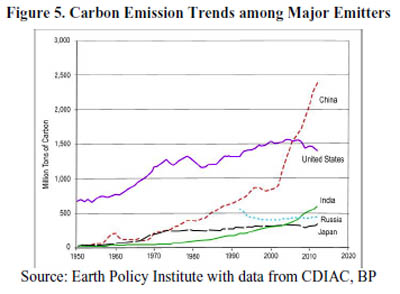
Without dramatic changes, UNEP projects a 2°C (3.6°F) rise above pre–industrial levels in 20–30 years, accelerating changing climate, ocean acidity, changes in disease patters, and saltwater intrusions into freshwater areas worldwide. FAO reports that 87% of global fish stocks are either fully exploited or overexploited. Typhoon Haiyan that devastated the Philippines in November 2013 had gusts reaching 235 miles per hour and a storm surge of water swelling as high as 20 feet, making it the most powerful tropical storm on record to make landfall. Oceans absorb about 33% of human–generated CO2, but their ability to continue doing this is being reduced, with changing acidity and dying coral reefs and other living systems.
In just 36 years (by 2050) the world needs to create enough electrical production capacity for an additional 3.7 billion people. There are 1.2 billion people without electricity today (17% of the world), and an additional 2.4 billion people will be added to the world’s population between now and 2050. Compounding this is the requirement to decommission aging nuclear power plants and to replace or retrofit fossil fuel plants. The cost of nuclear power is increasing, while the cost of renewables is falling. Wind power passed nuclear as Spain’s leading source of electricity. However, fossil fuels (coal, oil, and natural gas) will continue to supply the vast majority of baseload electricity past 2050 unless there are major social and technological changes. About 3 billion people still rely on traditional biomass for cooking and heating. If the long–term trends toward a wealthier and more sophisticated world continue, our energy demands by 2050 could be more than expected. However, the convergences of technologies are accelerating rapidly to make energy efficiencies far greater by 2050 than forecast today.
Because of falling water tables around the world, climate change, various forms of water pollution, and an additional 2.4 billion people in just 36 years (the majority in Asia), some of the people with safe water today may not have it in the future unless significant changes are made. Major progress was made over the past 25 years that provided enough clean water for an additional 2 billion people, but then water tables were higher, climate change was slower, and pollution was less. According to the OECD, half the world could be living in areas with severe water stress by 2030.
The UN’s mid–range forecast is that the current 7.2 billion people will grow to 9.6 billion by 2050 and there will be as many people over 65 as under 15, requiring new concepts of retirement or work. Average life expectancy at birth has increased from 48 years in 1955 to 70.5 years today. Future scientific and medical breakthroughs could give people longer and more productive lives than most would believe possible today. For example, uses of genetic data, software, and nanotechnology will help detect and treat disease at the genetic or molecular level. As a result, people will work longer and create many forms of tele–work, reducing the economic burden on younger generations and maintaining a better quality of life. In the meantime, because people are living longer, health care costs are increasing, and the shortage of health workers is growing, telemedicine and self–diagnosis via biochip sensors and online expert systems will be increasingly necessary.
The continued acceleration of S&T is fundamentally changing what is possible, and access to this knowledge is becoming universally available. But little news coverage, educational curricula, or the general public who elect political leaders seem aware of the extraordinary changes and consequences that need to be discussed. For example, China’s Tianhe–2 supercomputer is the world’s fastest computer at 33.86 petaflops (quadrillion floating point operations per second) — passing the computational speed of a human brain (though not its cognitive abilities). Individual gene sequencing is available for $1,000 that will lead to individual genetic medicine, while human pancreatic cells have been changed into liver cells and skin cells into heart cells. Synthetic biology is creating new life forms from computer designs. Nano–scale robots are being developed that should be able to manage nano–scale building processes for novel materials. A Higgs–like particle has been discovered that could explain the fundamental ability of particles to acquire mass. Quantum entanglement of billions of particle pairs could revolutionize communications and possibly transportation, and quantum building blocks (qubits) have been embedded into nanowires to lead to quantum computers. Although seemingly remote from improving the human condition, such basic science is necessary to increase the knowledge that applied science and technology draws on to improve the human condition.
Yet the acceleration of scientific and technological change seems to grow beyond conventional means of ethical evaluation. Is it ethical to clone ourselves, to bring dinosaurs back to life, or to invent thousands of new life forms through synthetic biology? Is it ethical to implement new S&T developments without proper safety testing or to develop new forms of weapons without human control over their use and safe disposal? Should basic scientific research be pursued without direct regard for social issues and the society that funds it? Might social considerations impair progress toward a truthful understanding of reality? Since journalists have to “hype” to be read in such an information-noisy world, truth can be distorted, resulting in a cynical public. We need a global collective intelligence system to track S&T advances, forecast consequences, and document a range of views so that all can understand the potential consequences of new and possible future S&T.
Although the empowerment of women has been one of the strongest drivers of social evolution over the past century, violence against women is the largest war today, as measured by death and casualties per year. Globally, 35% of women have experienced physical and/or sexual violence, and 38% of all murders of women are committed by intimate partners. While the gender gaps for health and educational attainment were closed by 96% and 93% respectively, according to the 2013 Global Gender Gap by the World Economic Forum, the gap in economic participation has been closed by only 60% and the gap in political outcomes by only 21% globally. Women account for 21.3% of the membership of national legislative bodies worldwide, up from 11.3% in 1997.
It is not reasonable to expect the world to cooperatively create and implement strategies to build a better future without some general agreement about what that desirable future is. Such a future should not be built on unrealistic fantasies unaware of the global situation. It should also be aware of the extraordinary possibilities. The overviews of the 15 Global Challenges in Chapter 1 gives a framework for understanding the current situation and prospects that have been systematically updated over the past seventeen years and with the accumulative participation of over 4,500 creative and knowledgeable people. The Global Challenges can be used as input to strategic development processes and university courses and can help the general public to understand what is important about future possibilities. This work is continuously updated with much greater detail in the Global Futures Intelligence System at www.themp.org.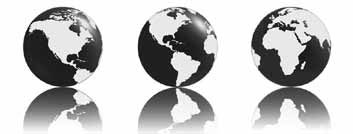
Chapter 2, Hidden Hunger: Unhealthy Food Markets in the Developing World, shares an international assessment of the causes of and solutions to the increasing problem of hidden hunger: the intake of sufficient calories but with little nutritious value, vitamins, and minerals. Although the share of people in the world who are hungry has fallen from over 30% in 1970 (when world population was 3.7 billion) to 15% today (with world population at over 7 billion) — the vast majority of whom are in Africa and Asia — concerns are increasing over the variety and nutritional quality of food. FAO estimates that some 30% of the population (2 billion people) suffers from hidden hunger. Some researchers argue that industrial agriculture reduces the nutrient content of crops, thus escalating the risk of hidden hunger. The International Food Policy Research Institute’s Global Hunger Index report notes that many of the unhealthy food conditions in the developing world are related to poor government social policies, income inequalities, inefficient farming, post–traumatic stress following civil wars, and the low status and educational level of women.
Chapter 3, Vulnerable Natural Infrastructure in Urban Coastal Zones, shares an international assessment of the causes of and solutions to the increasing deterioration of the natural infrastructure along the urban coastal zones around the world. This deterioration diminishes nature’s ability to reduce the impacts of hurricanes, tsunamis, and pollution, as it also negatively affects ecosystem services essential to livelihood. Over half the people in the world live within 120 miles of a coastline. Hence, without appropriate mitigation, prevention, and management of the natural infrastructure within urban coastal zones, billions of people will be increasingly vulnerable to a range of disasters. Chapter 4, SIMAD and Lone Wolf Terrorism Prospects and Potential Strategies to Address the Threat, shares an international assessment of the increasingly destructive power of individuals acting alone. The number of terrorism incidents increased over the past 20 years, reaching 8,441 in 2012 and more than 5,000 in the first half of 2013. Of all terrorism, the lone wolf type is the most insidious, because it is exceedingly difficult to anticipate, given the actions and intent of individuals acting alone. The average opinion of the international panel participating in this study is that nearly a quarter of terrorist attacks carried out in 2015 might be by a lone wolf and that the situation might escalate: about half of the participants in the study thought that lone wolf terrorists might attempt to use weapons of mass destruction around 2030.
Chapter 5, Global Futures Intelligence System, explains an approach to bringing important information about the future together with expert judgments and decision support software in new structures for continuous updating and improvements to create collective intelligence and wisdom about the future. Throughout Chapter 1, references are made to GFIS as the online location at www.themp.org for more detailed information on a subject that is continually updated. Each of the 15 Global Challenges features a menu that includes the following: both a short and a detailed report; a situation chart of the present and desired situation, as well as potential policies for progress; news aggregated from selected RSS feeds; a scanning system with annotated information; and key related web resources, books, papers, models, discussions, questionnaires, and lists of edits to these items. The collective intelligence emerges in GFIS from synergies among data/information/knowledge, software/hardware, and experts and others with insight that continually learn from feedback to produce just–in–time knowledge for better decisions than any of these elements acting alone. Figure 6 is a graphic illustration of these interactive elements.
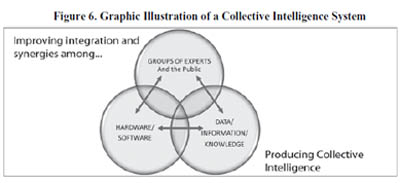
The accelerating rates of changes discussed in the State of the Future will eventually connect humanity and technology into new kinds of decisionmaking with global real–time feedback. GFIS is an early expression of that future direction, as is the 2013–14 State of the Future.
You can get the full report at 2013-14 State of the Future
The Future Now Show : Digital Startups from Asia / Innovating in Emerging Economies
Shape the future now, where near-future impact counts and visions and strategies for preferred futures start.
Do we rise above global challenges? Or do we succumb to them? The Future Now Show explores how we can shape our future now – where near-future impact counts. We showcase strategies and solutions that create futures that work.
Every month we roam through current events, discoveries, and challenges – sparking discussion about the connection between today and the futures we’re making – and what we need, from strategy to vision – to make the best ones.
The Future Now Show
February 2015
about Governance for All / Philosophy unbound / Robotics and A.I. and …
Featuring
Katie Aquino aka “Miss Metaverse”, Futurista™, USA
Karin Jironet, Co-founder of In Claritas, the Netherlands
Markus Petz, Head of Special Projects & Development, Experience Alternative Tampere, Austria
Annegien Blokpoel, Founder & CEO, PerspeXo, the Netherlands
Paul Holister, Editor, Summary Text
about Governance for All and …
The westernised world seems to be living in a state of increasing fear, with many believing we face a clash of civilisations. On one side our cherished democratic ways and on the other, it seems, a rigid, hierarchical (religious) force hell-bent on destroying us. Is there an outlook that is more inclusive of the differences and would we even see it in this polarised climate (which the Hebdo attack may have been intended to worsen)? Might causes of the clash be going unrecognised, like blowback from things we have done in their countries. Does our fear maybe even stem from insecurity inflicted on ourselves by globalisation? When the very nature and causes of the situation are so clouded, how do you decide on a direction?
about Philosophy unbound and …
Philosophy unbound is a group trying to reclaim philosophy from stuffy academia and bring it alive for people in something akin to the underground music scene. (Imagine your teenage daughter of a Saturday night saying “Dad, I’m going to a philosophy gig in town tonight. I might be home late.”) By keeping it practical, relevant to people’s lives and participative, the hope is that it will spread widely. Will it? What broader impact might it have? And if you want to get really speculative, how would it look with the involvement of enhanced humans or artificial intelligences?
Computing power is growing exponentially, and technological advance is accelerating – maybe also exponentially. There is no obvious reason this will stop. Look far enough ahead – and given the nature of exponential growth that might not be so far – and our future offers artificial intelligences that make us look puny, the possibility of humans merging with said intelligences and wild ideas like uploading our consciousness into immortal machines that could head out to the stars, unfettered by the frailty of human bodies. But what is to stop an elite few from taking the spoils and leaving the rest of us behind? We keep losing jobs to machines and this won’t stop so why are working hours and the retirement age going up? A classic utopia vs dystopia discussion seems in order. Which way are we leaning?
February Event in London: the future of Collective Intelligence

The Club of Amsterdam visits London.
the future of Collective Intelligence
February 11, 2015, 7-9pm
Location: The Cube, Studio 5, 155 Commercial Street, London E1 6BJ
This is a collaboration between The Cube and the Club of Amsterdam
Content
How will humanity manage the transition from a human based intelligence to a superior machine intelligence in a constructive, peaceful and practical way?
The emergence of Global Intelligence marks the fundamental transition from event-based development and event-based learning to continuous network enabled parallel development and continuous learning, by man, and by machine; simultaneously and complimentary. Similar to aspen trees, where the roots grow for 100s of meter underground, to meet roots of other aspen trees, to exchange information about water and soil conditions, the global networks of machines and its operators begin more and more to understand in real-time the causalities of changes in information streams and react in real-time as well. This process will shape the future more than anything else of the past 1,000 years. One of the most profound changes will be that Intelligence will not be any longer a competitive process, but a complimentary and cooperative process. This will shape, how we govern countries, conduct commerce and manage crisis.

with Hardy Schloer, Managing Director, Schloer Consulting Group,
Advisory Board, Club of Amsterdam

When you join THECUBE, you join a curated, diverse and smart community of scientists, engineers, designers, technologists, artists, futurists and anthropologists. We help our members innovate through our events, innovation labs and one to one mentoring. As a community we actively collaborate to create innovative solutions via our consultancy and independent projects.
The physical space is open plan and designed to make you feel calm, focused and happy. We have created a space that is a tool for the 21st century work needs, this means no cubicles, minimum artificial light, art, natural elements and openness.
Our story began as a response to the financial crash of 2008; we hypothesised that it was the start of an economic and anthropological pivot. This kind of pivot brings monumental change, which needs a new way of thinking and tools. In 2014 we are starting a series of workshops which will extrapolate tools and intelligence from neuroscience, culture and industrial engineering.
thecubelondon.com
The Asian Square Dance – Japan
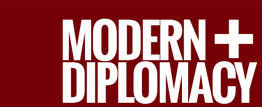

By Michael Akerib, Vice-Rector SWISS UMEF UNIVERSITY
Japan
Japan’s population of 127 million, of which nearly a quarter is over 65, is on a long-term downward trend, and is expected to lose one third of its inhabitants by 2050 and by two thirds in 2100. It has the world’s longest life expectancy and the lowest child mortality rate. The aging population translates into a population that is rapidly both aging and shrinking. Labor availability is already an issue particularly considering the historical reluctance of integrating immigrants – foreigners account for only 2% of the population. An aging population is also synonymous with lower prices for land and a lowering of real wages thus creating a strong deflationary pressure.
Facilitating entry into the employment market for women is an unpopular measure and will most probably result in an even lower birth rate than the present 1.47. Possibly Japanese industry will increase its reliance on robots.
The country suffers from other woes: natural disasters, deflation, and an increasingly uneasy relationship with China.
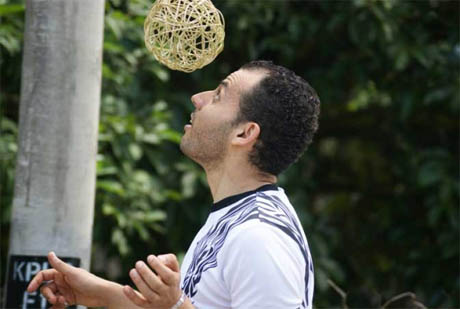
Credits: BFA 2010 (ab.eu)
Japanese corporations have made major investments in Asia, to be present in these markets as they expand, but also to take advantage of lower labor costs. This has reduced the dependence of Japanese corporations on the yen, a traditionally strong currency.
Japan, together with the US, is the largest shareholder of the Asian Development Bank in which there is a Japan Special Fund. Under Prime Minister Abe, and in contradiction with the cultural concept of sakoku or isolationism from the rest of the world, the country has been eager to create an arc of freedom and prosperity extending from Japan through South East and South Asia to the Middle East. This is viewed with alarm by both China and Russia that sees it as a means of containing them. In Asia, generally, Japan is a partner co-opted reluctantly as memories of World War II are still vivid and Japan, no longer wanting to be apologetic about that part of history, is reviving these painful memories.
Japan wants to have friendly relations with other countries in the area so as to counterbalance the rise of China. Thus, it has recently agreed to a security alliance with Australia, and is working at improving its relations with India, Russia and South Korea, the latter being a country in which Japanese are simply hated.
The limitation is essentially budgetary as Japan’s economy will face large challenges in the coming years and may no longer be able to sustain its place as the world’s second largest economy. Its ranking by GDP per capita has already decreased from the 4th to the 20th rank in fifteen years and its share of world GDP is only 10% as against 18% in the mid-1990s. The country has a large sovereign debt. Over a quarter of GDP is spent on health and nursery care and family benefits.
Prime Minister Abe wants to delete Article 9 of the constitution which prohibits war as a foreign policy instrument and does not allow the country to have an army and thus gain a larger independence from the US. It raises the issue of a possible nuclearization of the country’s military.
Indeed, Japan has undoubtedly the technological capabilities of building a nuclear weapon. It sees itself threated by the rise of China, the nuclear ambitions of North Korea, and is uneasy about its dependency on the US, wondering if the US public opinion would still, after the Iraqi fiasco, and the non-intervention in Georgia and the Ukraine, let its forces engage in foreign combat activities.
The government, however, is well aware that if it does not develop nuclear weapons, it would instill even greater distrust among its Asian partners and may well start a race to the bomb in South Korea and Taiwan.
Japan spends a larger budget on the military than China does, and its naval power is considerable. Investments are made in high-technology weaponry and in particular satellite observation and submarine detection. It is expected to spend USD 240 billion on items including aircraft and amphibious landing ships.
Japan is integrated in the US-led Theater Missile Defense System, is considered to have the world’s third best army, thus considerably reducing the possible threats that China could exercise in the region. It has also announced the development of satellite capabilities in liaison with the US.
It has recently created a Ministry of Defense. In December 2007, its Navy successfully tested n American anti-missile system. Four such interception systems are included in the defense setup. While officially their purpose is to protect Japan from North Korean missiles, they play an important part in the defense of Taiwan should China attempt an invasion. Japan, as well as the US, have repeatedly stated that they would not stand still should China decide to invade the island state.
Read also
The Asian Square Dance – Part 1
The Asian Square Dance – Part 2: China
The Asian Square Dance – Part 3: India
Club of Amsterdam blog

Club of Amsterdam blog
http://clubofamsterdam.blogspot.com
Socratic Design
by Humberto Schwab, Philosopher, Owner, Humberto Schwab Filosofia SL, Director, Club of Amsterdam
The Ukrainian Dilemma and the Bigger Picture
by Hardy F. Schloer, Owner, Schloer Consulting Group – SCG, Advisory Board of the Club of Amsterdam
The impact of culture on education
by Huib Wursten, Senior Partner, itim International and
Carel Jacobs is senior consultant/trainer for itim in The Netherlands, he is also Certification Agent for the Educational Sector of the Hofstede Centre.
What more demand for meat means for the future
by Christophe Pelletier, The Happy Future Group Consulting Ltd.
Inner peace and generosity
by Elisabet Sahtouris, Holder of the Elisabet Sahtouris Chair in Living Economies, World Business Academy
News about the Future

International Year of Light 2015
The International Year of Light and Light-based Technologies 2015 is a global initiative adopted by the United Nations to raise awareness of how optical technologies promote sustainable development and provide solutions to worldwide challenges in energy, education, agriculture, communications and health.

IFTF and The Rockefeller Foundation announce the release of the Future of Youth Employment report. The report offers an in-depth look at the changing nature of work in the United States — from microwork, to new coordination and automation technologies, and beyond. The report explores challenges and opportunities these changes present for poor and vulnerable youth, and suggests policies and actions corporations, governments, and nonprofits can take to ensure positive futures for them. In 2013, 22.5% of workers aged 16-19 were unemployed, compared to 5.1% of workers aged 55-64. The youth unemployment epidemic has no easy solution; the disruptions emerging today can either exacerbate the problem, or we can harness them to improve the lives of young people.
Recommended Book
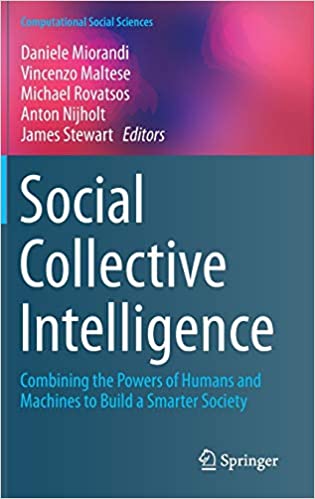
Social Collective Intelligence: Combining the Powers of Humans and Machines to Build a Smarter Society
by Daniele Miorandi (Editor), Vincenzo Maltese (Editor), Michael Rovatsos (Editor), Anton Nijholt (Editor), James Stewart (Editor)
The book focuses on Social Collective Intelligence, a term used to denote a class of socio-technical systems that combine, in a coordinated way, the strengths of humans, machines and collectives in terms of competences, knowledge and problem solving capabilities with the communication, computing and storage capabilities of advanced ICT.
Social Collective Intelligence opens a number of challenges for researchers in both computer science and social sciences; at the same time it provides an innovative approach to solve challenges in diverse application domains, ranging from health to education and organization of work.
The book will provide a cohesive and holistic treatment of Social Collective Intelligence, including challenges emerging in various disciplines (computer science, sociology, ethics) and opportunities for innovating in various application areas.
By going through the book the reader will gauge insight and knowledge into the challenges and opportunities provided by this new, exciting, field of investigation. Benefits for scientists will be in terms of accessing a comprehensive treatment of the open research challenges in a multidisciplinary perspective. Benefits for practitioners and applied researchers will be in terms of access to novel approaches to tackle relevant problems in their field. Benefits for policy-makers and public bodies representatives will be in terms of understanding how technological advances can support them in supporting the progress of society and economy.
The War Prayer

A personal introduction to Mark Twain’s “The War Prayer”
By Dario Poli
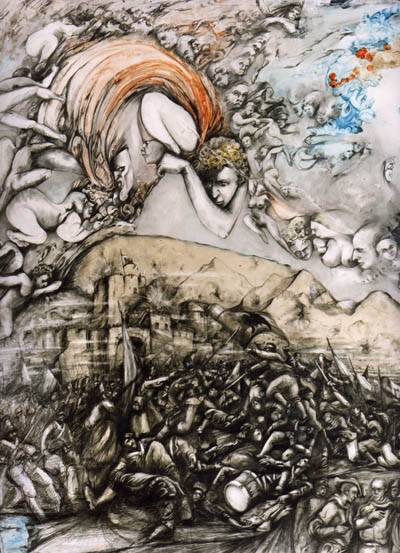
Apocalypse-Painting by Dario Poli aged 16 years old from “The Prophecies of Nostradamus” Published Studio Editions Ltd England & Karl Muller Verlag Germany 1995
There is considerable visual evidence shown by the international media of wars large and small currently taking place around the world, and threats of new wars being openly discussed by professional pundits, politicians, legal experts and business elites, most of whom have never been in a real conflict or faced personal danger or injury.
We the ordinary public going about our everyday business, are bombarded daily in the media outlets by the word “war”; the war on want, war on drugs, war on poverty; war on carbon, war on disease, war on crime, war on illiteracy, war against injustice, war of aggression, war of words, war against racism, war against intolerance and the war on terror. It appears that mankind is in a state of eternal war against its own social problems, the class war and now cyber wars, but with no solutions in sight.
We are told that war is the “price of freedom.” However from an historical perspective, in reality it usually results in the “loss of freedom” when we engage in war. The subtle infiltration of the word “war” into our subconscious is constant and needs to be understood as the ramifications can be very serious.
Any war enterprise however well prepared, is a hazardous, unpredictable undertaking, resulting in horrific experiences for those who fight them, as well as for the civilians, the animal life, the waste and contamination of our natural environment, not to mention the physiological and unending psychological trauma and problems of the victims. All suffer the painful consequences, including the enormous destruction of property, infrastructure and the irreplaceable loss of priceless art, culture and civilization.
All this barbarity because of the deliberate intentions and actions, of those so few in number, using laws for war, created by the few for this purpose, who lead us the majority, into these risky adventures and horrendous conflicts, that in final analysis, come to an abrupt end usually due to immense material and human destruction, the high financial losses and the sheer exhaustion of the populations involved. Conflicts always have to be resolved by some form of dialogue and peaceful agreements, despite who is the winner and loser.
All wars by their very nature are vile, nasty and destructive, as the finest of our youth at the orders of the oldest, perish or are permanently disfigured in conflict. War heavily sustained by a suffocating blanket of misinformation and double speak, is death, murder, rape, torture, incarceration and ruin. War always destroys wealth and liberty and it can eradicate civilizations. According to George Orwell, ‘all the war propaganda, all the screaming and lies and hatred, comes invariably from people who are not fighting.
Amazingly despite all the above knowledge of war and its consequences, this peace normally holds until the next war breaks out and then the whole grizzly business begins again with renewed vigour, each side forcefully proclaiming their just cause, ingeniously holstered onto the trusting simplicity of the enthusiastically stimulated tribal patriotism of the majority of the populations of those involved, who still obediently follow the instructions and orders of the few, as if nothing had been learned from the previous tragedy, as they march meekly into the open doors of the house of carnage, to be savagely minced in the unmerciful war machine. Their cries of pity and fear vanishing unheeded into the universal ether, together with millions of tears washed away into a river of their precious blood.
Arthur Koestler observed “The most persistent sound which reverberates through men’s history is the beating of war drums.”
“I confess without shame that I am tired and sick of war. Its glory is all moonshine. It is only those who have neither heard the shrieks and groans of the wounded, who cry aloud for more blood, more vengeance, more desolation. War is Hell.” ~ Civil War Union General William Tecumseh Sherman
“Statesmen are the most directly responsible for the continuation of a language of violence. They should be the first to speak the language of peace.”
…The Wreck of Europe, Nitti… 1922. Italy.
Humans daily face thousands of ways of dying from accidents and a myriad of diseases waiting to take our lives, but this appears not to be sufficient danger for us to face. Instead we deliberately increase our own peril and survival by skilfully, often ingeniously and effectively increasing the levels of killings by wars. What an incredible waste of energy, time and resources. Wars need to end as there are no victories, and as Benjamin Franklin noted “there was never a good war or a bad peace.“
Mark Twain‘s powerful The War Prayer is a reminder of the absurdity and stupidity of war, especially for those who have to fight them and is a timely warning to us all. – Dario Poli
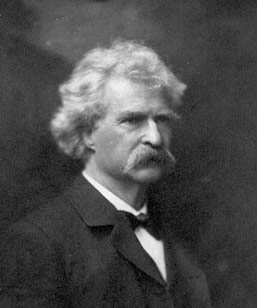
The War Prayer
By Mark Twain
It was a time of great and exalting excitement. The country was up in arms, the war was on, in every breast burned the holy fire of patriotism; the drums were beating, the bands playing, the toy pistols popping, the bunched firecrackers hissing and sputtering; on every hand and far down the receding and fading spreads of roofs and balconies a fluttering wilderness of flags flashed in the sun; daily the young volunteers marched down the wide avenue gay and fine in their new uniforms, the proud fathers and mothers and sisters and sweethearts cheering them with voices choked with happy emotion as they swung by; nightly the packed mass meetings listened, panting, to patriot oratory which stirred the deepest deeps of their hearts and which they interrupted at briefest intervals with cyclones of applause, the tears running down their cheeks the while; in the churches the pastors preached devotion to flag and country and invoked the God of Battles, beseeching His aid in our good cause in outpouring of fervid eloquence which moved every listener.
It was indeed a glad and gracious time, and the half dozen rash spirits that ventured to disapprove of the war and cast a doubt upon its righteousness straightway got such a stern and angry warning that for their personal safety’s sake they quickly shrank out of sight and offended no more in that way.
Sunday morning came – next day the battalions would leave for the front; the church was filled; the volunteers were there, their faces alight with material dreams – visions of a stern advance, the gathering momentum, the rushing charge, the flashing sabres, the flight of the foe, the tumult, the enveloping smoke, the fierce pursuit, the surrender! – then home from the war, bronzed heroes, welcomed, adored, submerged in golden seas of glory! With the volunteers sat their dear ones, proud, happy, and envied by the neighbors and friends who had no sons and brothers to send forth to the field of honor, there to win for the flag or, failing, die the noblest of noble deaths. The service proceeded; a war chapter from the Old Testament was read; the first prayer was said; it was followed by an organ burst that shook the building, and with one impulse the house rose, with glowing eyes and beating hearts, and poured out that tremendous invocation – “God the all-terrible! Thou who ordainest, Thunder thy clarion and lightning thy sword!”
Then came the “long” prayer. None could remember the like of it for passionate pleading and moving and beautiful language. The burden of its supplication was that an ever-merciful and benignant Father of us all would watch over our noble young soldiers and aid, comfort, and encourage them in their patriotic work; bless them, shield them in His mighty hand, make them strong and confident, invincible in the bloody onset; help them to crush the foe, grant to them and to their flag and country imperishable honor and glory.
An aged stranger entered and moved with slow and noiseless step up the main aisle, his eyes fixed upon the minister, his long body clothed in a robe that reached to his feet, his head bare, his white hair descending in a frothy cataract to his shoulders, his seamy face unnaturally pale, pale even to ghastliness. With all eyes following him and wondering, he made his silent way; without pausing, he ascended to the preacher’s side and stood there, waiting.
With shut lids the preacher, unconscious of his presence, continued his moving prayer, and at last finished it with the words, uttered in fervent appeal,” Bless our arms, grant us the victory, O Lord our God, Father and Protector of our land and flag!”
The stranger touched his arm, motioned him to step aside – which the startled minister did – and took his place. During some moments he surveyed the spellbound audience with solemn eyes in which burned an uncanny light; then in a deep voice he said
“I come from the Throne – bearing a message from Almighty God!” The words smote the house with a shock; if the stranger perceived it he gave no attention. “He has heard the prayer of His servant your shepherd and grant it if such shall be your desire after I, His messenger, shall have explained to you its import – that is to say, its full import. For it is like unto many of the prayers of men, in that it asks for more than he who utters it is aware of – except he pause and think.
“God’s servant and yours has prayed his prayer. Has he paused and taken thought? Is it one prayer? No, it is two – one uttered, the other not. Both have reached the ear of His Who hearth all supplications, the spoken and the unspoken. Ponder this – keep it in mind. If you beseech a blessing upon yourself, beware! lest without intent you invoke a curse upon a neighbor at the same time. If you pray for the blessing of rain upon your crop which needs it, by that act you are possibly praying for a curse upon some neighbor’s crop which may not need rain and can be injured by it.
“You have heard your servant’s prayer – the uttered part of it. I am commissioned by God to put into words the other part of it – that part which the pastor, and also you in your hearts, fervently prayed silently. And ignorantly and unthinkingly? God grant that it was so! You heard these words: ‘Grant us the victory, O Lord our God!’ That is sufficient. The whole of the uttered prayer is compact into those pregnant words. Elaborations were not necessary. When you have prayed for victory you have prayed for many unmentioned results which follow victory – must follow it, cannot help but follow it. Upon the listening spirit of God the Father fell also the unspoken part of the prayer. He commandeth me to put it into words. Listen!
“O Lord our Father, our young patriots, idols of our hearts, go forth to battle – be Thou near them! With them, in spirit, we also go forth from the sweet peace of our beloved firesides to smite the foe. O Lord our God, help us to tear their soldiers to bloody shreds with our shells; help us to cover their smiling fields with the pale forms of their patriot dead; help us to drown the thunder of the guns with the shrieks of their wounded, writhing in pain; help us to lay waste their humble homes with a hurricane of fire; help us to wring the hearts of their unoffending widows with unavailing grief; help us to turn them out roofless with their little children to wander unfriended the wastes of their desolated land in rags and hunger and thirst, sports of the sun flames of summer and the icy winds of winter, broken in spirit, worn with travail, imploring Thee for the refuge of the grave and denied it – for our sakes who adore Thee, Lord, blast their hopes, blight their lives, protract their bitter pilgrimage, make heavy their steps, water their way with their tears, stain the white snow with the blood of their wounded feet! We ask it, in the spirit of love, of Him Who is the Source of Love, and Who is ever-faithful refuge and friend of all that are sore beset and seek His aid with humble and contrite hearts. Amen.
(After a pause)
“Ye have prayed it; if ye still desire it, speak! The messenger of the Most High waits.”
It was believed after wards that the man was a lunatic, because there was no sense in what he said.
Twain wrote The War Prayer during the U.S. war on the Philippines. Submitted it for publication, but on March 22, 1905, it was rejected as unsuitable by Harper’s Bazaar. Twain wrote to his friend Dan Beard, “I don’t think the prayer will be published in my time. None but the dead are permitted to tell the truth.” The War Prayer remained unpublished until 1923.
Dario Poli, born and educated in Scotland, is an artist, writer, music composer.
He wrote magazine published articles and illustrated several published books on Nostradamus.
He performed with his sister Delia in theatre and cabaret alongside many international stars and had radio TV and film to their credit. Dario, is co-author in the musical Drama on Princess Diana and is currently completing a new show titled “Amsterdam the Musical”.
Futurist Portrait: Marina Gorbis
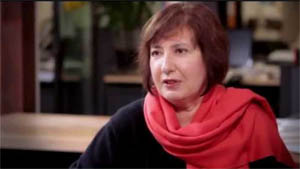
Marina Gorbis is a futurist and social scientist who serves as executive director to the Institute for the Future (IFTF), a Silicon Valley nonprofit research and consulting organization. In her 14 years with IFTF, Marina has brought a futures perspective to hundreds of organizations in business, education, government, and philanthropy to improve innovation capacity, develop strategies, and design new products and services.
Marina’s current research focuses on how social production is changing the face of major industries, a topic explored in detail in her book, The Nature of the Future: Dispatches from the Socialstructed World. She has also blogged and written for BoingBoing.net, FastCompany, Harvard Business Review, and major media outlets. A native of Odessa, Ukraine, yet equally at home in Silicon Valley, Europe, India, and Kazakhstan, Marina is particularly well suited to see things from a global viewpoint. She has keynoted such international events as the World Economic Forum, The Next Web Conference, NEXT Berlin, the World Business Forum, the National Association of Broadcasters annual convention, and the Western Association of Schools and Colleges annual conference. She holds a BA in psychology and a master’s of public policy from UC Berkeley.
Marina on Making the Future
“To paraphrase Margaret Mead, we are all immigrants to the future; none of us is a native in that land. The very underpinnings of our society and institutions — from how we work to how we create value, govern, trade, learn, and innovate — are being profoundly reshaped. We are all migrating to a new land and should be looking at the new landscape emerging before us like immigrants: ready to learn a new language, a new way of doing things, anticipating new beginnings with a sense of excitement if also with a bit of understandable trepidation.”
The Future Of Education Eliminates The Classroom, Because The World Is Your Class
… ”Instead of worrying about how to distribute scarce educational resources, the challenge we need to start grappling with in the era of socialstructed learning is how to attract people to dip into the rapidly growing flow of learning resources and how to do this equitably, in order to create more opportunities for a better life for more people.”
The Nature of the Future: Dispatches from the Socialstructed World
By Marina Gorbis

A vision of a reinvented world
Large corporations, big governments, and other centralized organizations have long determined and dominated the way we work, access healthcare, get an education, feed ourselves, and generally go about our lives. The economist Ronald Coase, in his famous 1937 paper “The Nature of the Firm,” provided an economic explanation for this: Organizations lowered transaction costs, making the provision of goods and services cheap, efficient, and reliable. Today, this organizational advantage is rapidly disappearing. The Internet is lowering transaction costs — costs of connection, coordination, and trade — and pointing to a future that increasingly favors distributed sources and social solutions to some of our most immediate needs and our most intractable problems.
As Silicon Valley thought-leader Marina Gorbis, head of the Institute for the Future, portrays, a thriving new relationship-driven or socialstructed economy is emerging in which individuals are harnessing the powers of new technologies to join together and provide an array of products and services. Examples of this changing economy range from BioCurious, a members-run and free-to-use bio lab, to the peer-to-peer lending platform Lending Club, to the remarkable Khan Academy, a free online-teaching service. These engaged and innovative pioneers are filling gaps and doing the seemingly impossible by reinventing business, education, medicine, banking, government, and even scientific research. Based on extensive research into current trends, she travels to a socialstructed future and depicts an exciting vision of tomorrow.
The Nature of the Future – Marina Gorbis and David Pescovitz
Agenda

Season Events 2014 / 2015 London February 11, 2015 the future of Collective Intelligence Location: The Cube, Studio 5, 155 Commercial Street, London E1 6BJ This is a collaboration between The Cube and the Club of Amsterdam. London April 24, 2015 the future of Metro Vitality Location: ARUP London A collaboration between the Association of Professional Futurists and the Club of Amsterdam and hosted by ARUP Foresight + Research + Innovation. |
Special Supporters








Customer Reviews
Thanks for submitting your comment!